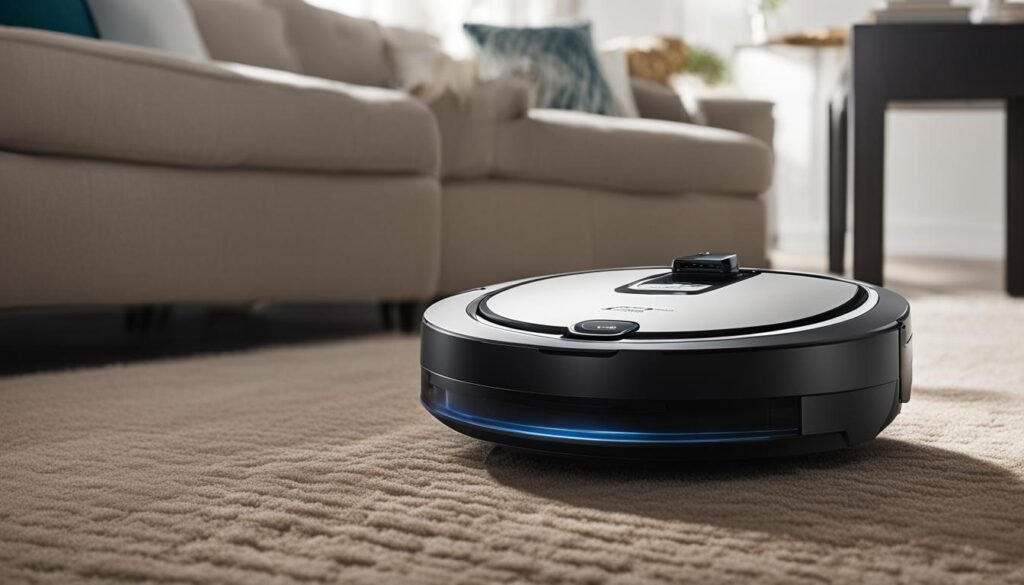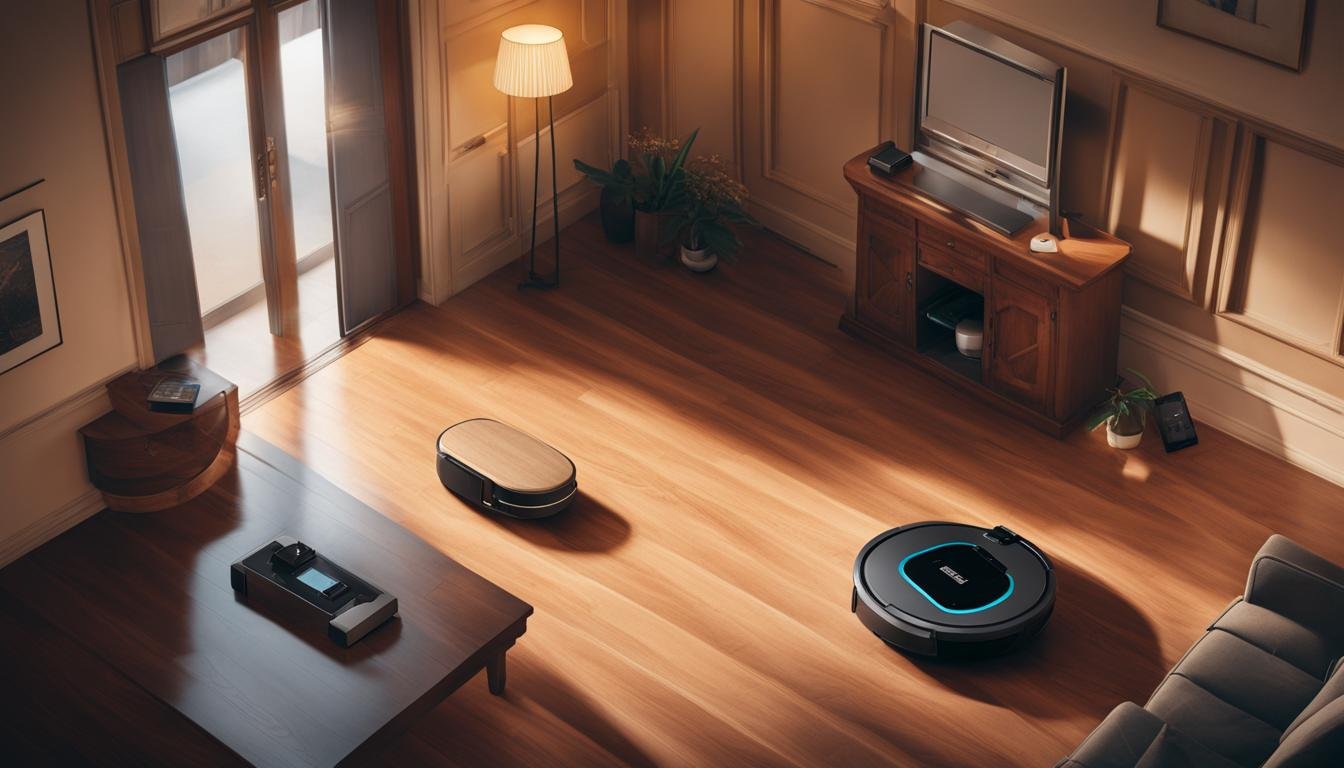Gone are the days of spending hours pushing a heavy vacuum cleaner around your home. With the advent of robot vacuum cleaners, keeping your floors clean has become easier and more convenient than ever. But if you’re new to using a robot vacuum cleaner, you may be wondering how to get started and make the most of this modern cleaning tool. In this comprehensive guide, I’ll walk you through the ins and outs of using a robot vacuum cleaner, from initial setup to troubleshooting tips.
Key Takeaways:
- Familiarize yourself with the features and functions of your robot vacuum cleaner to optimize its performance.
- Set up barriers and create a layout that promotes seamless navigation for your robot vacuum cleaner.
- Follow best practices to maximize efficiency, such as scheduling cleaning cycles and maintaining an obstacle-free environment.
- Program your robot vacuum cleaner to clean specific areas and handle different floor types.
- Keep an eye out for common troubleshooting issues and know how to address them effectively.
Getting Started: Robot Vacuum Cleaner Setup and Navigation
Before you unleash your robot vacuum cleaner on your home, it’s important to set it up properly and understand how it works. Most robot vacuums use advanced sensors and navigation systems to move around your space and clean efficiently. This section will cover topics such as mapping your home, creating barriers, and optimizing the layout for seamless navigation. You’ll also learn about the key features and functions of robot vacuum cleaners and how they contribute to their cleaning performance.
Setting up your robot vacuum cleaner is the first step to effortless cleaning. Follow these simple steps for a successful setup:
- Choose an appropriate location to place the charging dock. It should be easily accessible and near an electrical outlet.
- Familiarize yourself with the control panel or app of your robot vacuum. This will allow you to program cleaning schedules and adjust settings as needed.
- Ensure the brushes and filters are properly installed. These components are essential for effective cleaning and should be checked regularly for maintenance.
- Connect the charging dock to a power source. Once connected, your robot vacuum will automatically dock and charge when not in use.
- If your robot vacuum comes with mapping capabilities, allow it to scan and create a map of your home. This will enable more efficient cleaning and navigation.
Now that your robot vacuum cleaner is set up, let’s delve into how it actually works. Robot vacuums employ a combination of sensors, brushes, and suction power to clean your floors. Here are some key features you should be familiar with:
- Smart Navigation: Robot vacuums utilize various navigation technologies such as laser mapping, cameras, or infrared sensors to move around your space and avoid obstacles.
- Sensor Technology: These vacuums are equipped with sensors that detect stairs, walls, and furniture to prevent collisions and falls.
- Brushes and Suction: Robot vacuums feature rotating brushes and powerful suction to agitate and lift dirt, dust, and debris from different floor surfaces.
- Mapping and Cleaning Modes: Some models allow you to create virtual boundaries or no-go zones, customize cleaning schedules, and target specific areas for thorough cleaning.
“Robot vacuum cleaners are designed to make your life easier by taking care of the cleaning tasks, allowing you to focus on more important things. With their advanced navigation and cleaning features, they can efficiently maintain the cleanliness of your home.”
Understanding the setup process and the key features of a robot vacuum cleaner is crucial for effective cleaning and optimal performance. In the next section, we will explore tips and best practices to maximize cleaning efficiency and get the most out of your robot vacuum cleaner.
| Key Features | How They Contribute to Cleaning Performance |
|---|---|
| Smart Navigation | Efficiently navigates through your home, cleaning every corner and avoiding obstacles |
| Sensor Technology | Detects and avoids furniture, stairs, and other obstacles, preventing damage and accidents |
| Brushes and Suction | Effectively agitates and lifts dirt, dust, and debris from carpets, hardwood floors, and other surfaces |
| Mapping and Cleaning Modes | Allows you to customize cleaning schedules, create virtual boundaries, and target specific areas for thorough cleaning |
Maximizing Cleaning Efficiency: Tips and Best Practices
To get the most out of your robot vacuum cleaner, it’s important to follow some tips and best practices. By implementing these strategies, you can ensure that your robot vacuum operates at its optimal efficiency.
Preparing Your Home
Before starting a cleaning session, it’s essential to prepare your home to maximize the effectiveness of your robot vacuum. Here are a few tips:
- Clear any clutter and pick up small items from the floor to prevent them from interfering with the robot vacuum’s cleaning path.
- Secure loose cables and cords to avoid entanglement or damage to both the vacuum and the cords.
- Close doors to rooms you don’t want your robot vacuum to enter to ensure it focuses on the desired areas.
- Remove any obstacles that could impede the robot vacuum’s movement, such as loose rugs or low-hanging curtains.
By keeping your home tidy and obstacle-free, you’ll optimize the cleaning efficiency of your robot vacuum cleaner.
Scheduling Cleaning Cycles
Setting up a regular cleaning schedule for your robot vacuum can help maintain a clean and tidy home effortlessly. Consider the following when scheduling cleaning cycles:
- Program your robot vacuum to clean when you’re away or during times when you won’t be disturbed to minimize interference.
- Take into account high traffic areas and schedule more frequent cleaning cycles to keep them consistently clean.
By establishing a cleaning routine that suits your lifestyle and home’s needs, you can rely on your robot vacuum to maintain a spotless environment effortlessly.
Programming for Specific Areas and Floor Types
One of the advantages of modern robot vacuum cleaners is the ability to program them for specific areas and floor types. Here’s how to make the most of this feature:
- Utilize virtual walls or magnetic strips to create boundaries and prevent your robot vacuum from entering off-limits areas.
- Set up different cleaning modes or suction levels based on the type of flooring you have to optimize cleaning performance.
- If your robot vacuum supports it, program it to clean specific rooms or zones at different times to focus on the areas that need the most attention.
By customizing your robot vacuum’s programming to suit your home’s layout and flooring, you can ensure comprehensive and efficient cleaning for every surface.

With these tips and best practices, you’ll be able to maximize the cleaning efficiency of your robot vacuum cleaner, saving you time and effort in your cleaning routine.
Conclusion
Using a robot vacuum cleaner can be a game-changer for your cleaning routine, saving you time and effort. However, as with any appliance, there may be instances where troubleshooting is necessary to ensure its optimal performance.
In this guide, I have provided you with comprehensive instructions on how to effectively use a robot vacuum cleaner. From the initial setup and navigation to maximizing cleaning efficiency, you now have the knowledge to make the most of this modern cleaning tool.
Remember, if you encounter any issues with your robot vacuum cleaner, don’t panic. Refer to the troubleshooting guide provided by the manufacturer or consult their customer support. By addressing any problems promptly and following the guidelines mentioned, you can enjoy the benefits of a perpetually tidy home with minimal effort.
FAQ
How do I set up my robot vacuum cleaner?
To set up your robot vacuum cleaner, follow the manufacturer’s instructions. Typically, you’ll need to charge the device, connect it to your Wi-Fi, and install any necessary companion apps. You may also need to program the initial cleaning schedule and map your home using the device’s sensors.
How does a robot vacuum cleaner work?
Robot vacuum cleaners use advanced sensors and navigation systems to move around your space and clean efficiently. They typically utilize bump sensors, cliff sensors, and cameras to avoid obstacles and stairs. The device’s motor creates suction to capture dirt and debris, which is then collected in a dustbin for easy disposal.
What are some key features of robot vacuum cleaners?
Robot vacuum cleaners come with various features to enhance their cleaning performance. Some common features include mapping and navigation systems, virtual barriers to restrict certain areas, scheduling options, and the ability to handle different floor types. Some high-end models also offer advanced functionalities like room-specific cleaning and automatic dirt disposal.
How can I maximize the cleaning efficiency of my robot vacuum cleaner?
To maximize cleaning efficiency, ensure that your home is tidy and free of obstacles before each cleaning session. Clear the floor of small objects, cables, and pet toys. Additionally, you can program your robot vacuum to clean specific areas or create virtual barriers to prevent it from entering certain spaces. Run regular maintenance on the device, such as emptying the dustbin and cleaning the brushes and sensors.
How do I troubleshoot my robot vacuum cleaner?
If your robot vacuum cleaner encounters issues, consult the manufacturer’s troubleshooting guide provided with the device. Common troubleshooting steps include checking for blockages in the brushes or suction system, ensuring the device is charged and connected to Wi-Fi, and resetting the machine if necessary. If problems persist, contact customer support for further assistance.





Leave a Reply